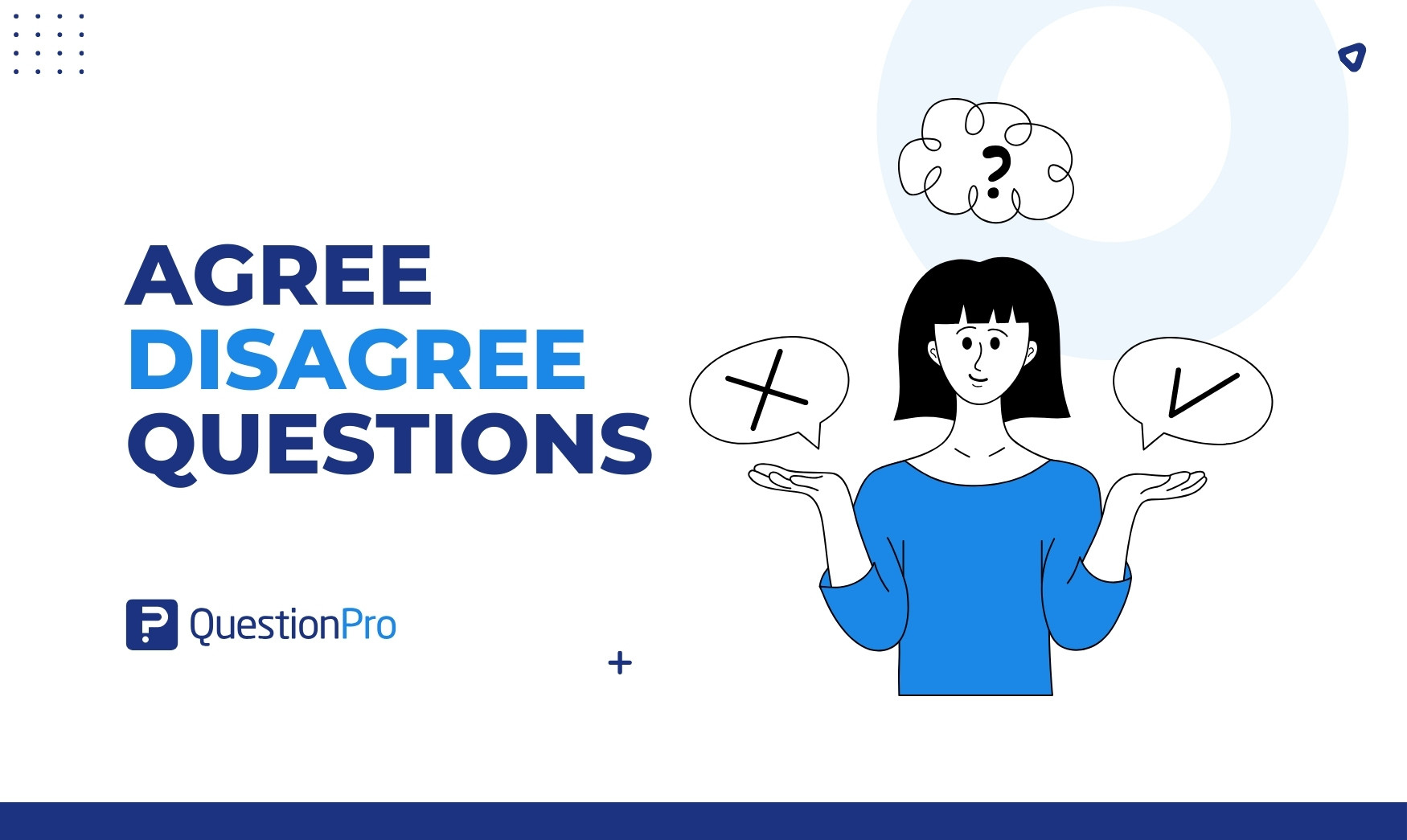

Have you ever wondered about the intricacies of opinions and attitudes, wishing there was a structured way to gauge and quantify them? Enter agree disagree questions – a powerful tool for surveys and research designed to unravel the complex tapestry of human perspectives.
Agree disagree questions are a specific type of survey item that prompts respondents to express their stance on various statements, using a Likert scale to convey the intensity of their agreement or disagreement. Whether knowing environmental concerns, software usability, team communication, training programs, or organizational policies, these questions quantitatively measure attitudes and opinions.
In this blog of agree disagree questions, we’ll journey through examples, guidelines for effective question crafting, and the challenges associated with this survey method.
But fear not, for we won’t leave you hanging – we’ll also introduce you to QuestionPro, a survey and research platform that acts as a guiding light in the intricate process of setting up agree disagree questions.
Content Index hideAgree disagree questions are a type of survey or questionnaire item that asks respondents to express their agreement or disagreement with a given statement.
These questions are commonly used in research, market studies, and various surveys to measure attitudes, opinions, or beliefs. Respondents typically choose from a predefined set of response options, often presented on a Likert scale.
Here are some examples of agree disagree questions:
Example 1:
Statement: “I find the user interface of our new software easy to navigate.”
Example 2:
Statement: “I feel satisfied with the level of communication within the team.”
Example 3:
Statement: “The company’s training programs adequately prepare employees for their roles.”
Example 4:
Statement: “I support the implementation of flexible work hours in our organization.”
Respondents choose the option that best reflects their agreement or disagreement with the statement. The Likert scale allows for a range of responses, from strong agreement to strong disagreement, with a neutral option in the middle.
These questions provide a quantitative measure of respondents’ opinions, enabling researchers to analyze and interpret the data in a structured way.
The importance of practical conversation skills cannot be overstated, especially when addressing agree-disagree questions. Survey creators often probe diverse topics, ranging from the role of healthcare providers to the significance of one’s own funeral.
Engaging in discussions on public pool hygiene or claiming that breakfast is the most important meal requires individuals to refrain from straight-lining their responses. This nuanced approach fosters better understanding and more thoughtful responses, ultimately contributing to the development of better students and informed perspectives.
Writing practical agree disagree questions involves careful consideration of the statements, clarity, and potential biases. Here are some guidelines to help you write agree disagree questions:
State each question clearly and succinctly. Avoid using jargon or complex language that might confuse respondents. A clear statement ensures that respondents understand what they are asked to agree or disagree with.
Strive for balance in your statements. Present both sides of an issue in a fair and unbiased manner. This helps obtain responses that reflect genuine opinions rather than leading respondents towards a particular answer.
Focus on one idea or concept per statement. Avoid combining multiple ideas into a single statement, as this can make it challenging for respondents to express their agreement or disagreement accurately.
If you have multiple agree disagree statements, consider randomizing their order. This helps prevent order effects, where the statement’s position may influence respondents in the questionnaire.
Include a Likert scale with response options that reflect varying degrees of agreement and disagreement. Standard options include “Strongly Agree,” “Agree,” “Neutral,” “Disagree,” and “Strongly Disagree.” This provides a structured way for respondents to express their opinions.
Conduct a pilot test with a small group of individuals before administering your survey research on a larger rating scale. This helps identify any potential issues with wording, clarity, or interpretation of the statements.
Take the time to review and revise your agree disagree questions. Solicit feedback from colleagues or experts to ensure the questions are well-constructed and effectively capture the information you seek.
QuestionPro is a survey and research platform that allows users to create, distribute, and analyze survey questions. QuestionPro provides features and functionalities to make the process easy and effective when setting up agree disagree questions. Here’s how QuestionPro can help:
Agree disagree questions serve as a valuable instrument for researchers seeking to quantify opinions and attitudes. Crafting these questions effectively is an art that involves clarity, balance, and careful consideration of potential biases.
Despite their effectiveness, agree-disagree questions come with challenges, such as limited response options, potential response bias, context sensitivity, and the tendency for respondents to choose neutral options. To overcome these challenges, it is essential to pilot test questions, review and revise them, and consider additional open-ended questions for deeper insights.
While challenges exist, leveraging advanced platforms like QuestionPro can significantly enhance the efficiency and reliability of the entire process. As we navigate the landscape of opinions and beliefs, agree-disagree questions remain a cornerstone in unraveling the intricate tapestry of human perspectives.